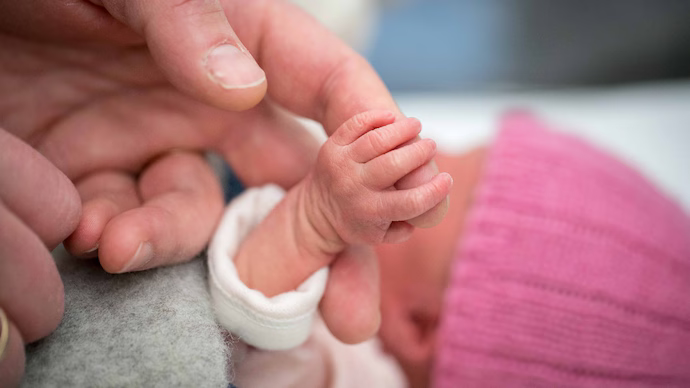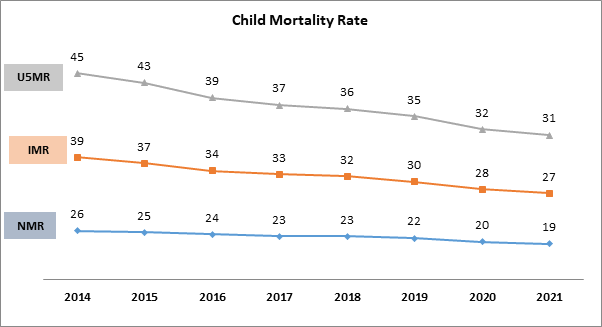India sees big drop in maternal and child deaths — SRS 2021 Report

In News: India sees big drop in maternal and child deaths — SRS 2021 Report
Context
According to the Sample Registration System (SRS) 2021 report released by the Registrar General of India, India has made significant progress in reducing maternal and child mortality. The latest estimates highlight the impact of improved access to healthcare, institutional deliveries, and government interventions under schemes such as LaQshya, POSHAN Abhiyaan, and Pradhan Mantri Surakshit Matritva Abhiyan.
Key Findings
- Maternal Mortality Ratio (MMR):
Declined from 130 (2014–16) to 93 (2019–21) per 1 lakh live births — a 28% reduction.
👉 India is on track to meet the SDG Target of MMR ≤ 70 by 2030. - Infant Mortality Rate (IMR):
Fell from 39 (2014) to 27 (2021) per 1,000 live births. - Neonatal Mortality Rate (NMR):
Dropped from 26 to 19 in the same period. - Under-Five Mortality Rate (U5MR):
Reduced from 45 to 31 per 1,000 live births. - Sex Ratio at Birth:
Improved from 899 (2014) to 913 (2021) girls per 1,000 boys — reflecting better awareness and enforcement of gender equality measures. - Total Fertility Rate (TFR):
Declined from 2.3 (2014) to 2.0 (2021) — indicating India is approaching replacement-level fertility.
Best Performing States (Low MMR)
| State/UT | MMR (per 1,00,000 live births) |
|---|---|
| Kerala | 20 |
| Maharashtra | 38 |
| Telangana | 45 |
| Andhra Pradesh | 46 |
| Tamil Nadu | 49 |
| Jharkhand | 51 |
| Gujarat | 53 |
| Karnataka | 63 |
Kerala leads with the lowest MMR due to strong public health systems, institutional deliveries, and high female literacy.
Child Health Progress
- U5MR ≤ 25 target achieved in 12 States/UTs including Kerala, Delhi, Tamil Nadu, Maharashtra, West Bengal, Karnataka, Punjab, Telangana, Himachal Pradesh, Andhra Pradesh, and Gujarat.
- NMR ≤ 12 target achieved by Kerala (4), Delhi (8), Tamil Nadu (9), Maharashtra (11), J&K (12), and Himachal Pradesh (12).
Government Interventions Driving the Change
- POSHAN Abhiyaan (2018) – Nutritional improvement in pregnant women, lactating mothers, and children.
- LaQshya Program – Ensuring quality care during labor and delivery.
- Janani Suraksha Yojana (JSY) and Janani Shishu Suraksha Karyakram (JSSK) – Promoting institutional deliveries and free maternity services.
- Pradhan Mantri Surakshit Matritva Abhiyan (PMSMA) – Regular antenatal check-ups for early detection of complications.
- RMNCH+A Strategy – Continuum of care across reproductive, maternal, newborn, child, and adolescent health.
- Digital Health Mission & SRS Data Platforms – Real-time data for evidence-based decision making.
Concerns & Challenges
- Regional disparities persist, especially in parts of northern and northeastern India.
- High MMR still observed in Assam, Madhya Pradesh, Uttar Pradesh, and Chhattisgarh.
- Inequities in healthcare access between rural and urban populations.
- Shortage of skilled birth attendants in remote areas.
Global Context
The findings align with the UN MMEIG’s “Trends in Maternal Mortality: 2000–2023”, which also noted a 40% global decline in maternal mortality since 2000 but warned of slower progress toward SDG 3.1 targets.
Way Forward
- Strengthen primary healthcare and maternal referral systems.
- Expand coverage of skilled birth attendance in rural and tribal regions.
- Invest in digital tracking for maternal health outcomes.
- Address social determinants — poverty, gender inequality, and education gaps.
- Focus on postpartum care and adolescent reproductive health.


UPDATED - May 16, 2025 2:15 PM | India Today